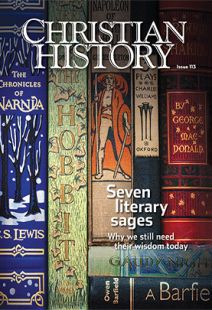Sermons in stone: Lewis comes to Poets’ Corner
When the father of English poetry, Geoffrey Chaucer, died in 1400, he was buried in Westminster Abbey, England’s coronation church. The transept where he rests has become known as “Poets’ Corner” because many other great figures of English literature—dramatists and novelists as well as poets—have been buried or memorialized alongside him. Shakespeare, Milton, and Jane Austen are just a few of them.
Now C. S. Lewis’s name joins that eminent fellowship. On the 50th anniversary of his death (November 22, 2013), a memorial to Lewis was unveiled in a thanksgiving service at Westminster Abbey attended by 1,000 people.
Prayers came from the rector of St. Mark’s, Belfast, where Lewis was baptized; from representatives of Magdalen College, Oxford, and Magdalene College, Cambridge, where he worked; and from the vicar of Holy Trinity, Headington Quarry, where he is buried.
Scripture passages were read by Lewis’s pupil, Francis Warner, and by his successor as professor of medieval and Renaissance English at Cambridge, Helen Cooper. Lewis’s stepson, Douglas Gresham, recited a passage from The Last Battle, and his editor, Walter Hooper, laid flowers on the memorial.
Former archbishop of Canterbury Dr. Rowan Williams, now master of Magdalene College, Cambridge, gave the address.
The choir sang “Veni Sancte Spiritus” by George Fenton from the film Shadowlands and a musical setting of Lewis’s poem, “Love’s as Warm as Tears”—the latter especially written for the occasion by royal wedding composer, Paul Mealor.
The memorial bears words from Lewis’s address to the Oxford Socratic Club, “Is Theology Poetry?”:
“I believe in Christianity as I believe that the Sun has risen, not only because I see it but because by it I see everything else.”
By Michael Ward
[Christian History originally published this article in Christian History Issue #113 in 2015]
Dr. Michael Ward is senior research fellow at Blackfriars Hall, University of Oxford, and professor of apologetics at Houston Baptist University, Texas. He is the author of Planet Narnia: The Seven Heavens in the Imagination of C. S. Lewis and co-editor of The Cambridge Companion to C. S. Lewis.Next articles
The storyteller
The stories of George MacDonald (1824-1905) showed goodness and holiness to Lewis and Chesterton—and show those same things to us
Kirstin Jeffrey JohnsonWhat C. S. Lewis learned from his “master”
Lewis’s recommendation to seekers: read George MacDonald
Kirstin Jeffrey JohnsonLearning what no one meant to teach
The educational experiences of C. S. Lewis (1898-1963)
Michael WardSupport us
Christian History Institute (CHI) is a non-profit Pennsylvania corporation founded in 1982. Your donations support the continuation of this ministry
Donate



